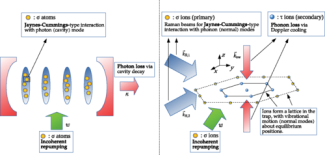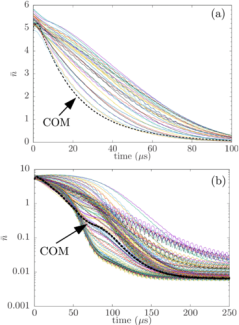Using analogies from cavity QED to engineer steady-state spin synchronization in a trapped-ion system.
Cooling curves for all the drumhead modes of a trapped-ion crystal.
Ultranarrow-linewidth atoms coupled to a lossy optical cavity mode synchronize, i.e., develop correlations, and exhibit steady-state superradiance when continuously repumped. This type of system displays rich collective physics and promises metrological applications. These features inspire us to investigate if analogous spin synchronization is possible in a different platform that is one of the most robust and controllable experimental testbeds currently available: ion-trap systems. We design a system with a primary and secondary species of ions that share a common set of normal modes of vibration. In analogy to the lossy optical mode, we propose to use a lossy normal mode, obtained by sympathetic cooling with the secondary species of ions, to mediate spin synchronization in the primary species of ions. Our numerical study shows that spin-spin correlations develop, leading to a macroscopic collective spin in steady state. We propose an experimental method based on Ramsey interferometry to detect signatures of this spin synchronization; we predict that correlations prolong the visibility of Ramsey fringes, and that population statistics at the end of the Ramsey sequence can be used to directly infer spin-spin correlations.




 The Physics Frontiers Centers (PFC) program supports university-based centers and institutes where the collective efforts of a larger group of individuals can enable transformational advances in the most promising research areas. The program is designed to foster major breakthroughs at the intellectual frontiers of physics by providing needed resources such as combinations of talents, skills, disciplines, and/or specialized infrastructure, not usually available to individual investigators or small groups, in an environment in which the collective efforts of the larger group can be shown to be seminal to promoting significant progress in the science and the education of students. PFCs also include creative, substantive activities aimed at enhancing education, broadening participation of traditionally underrepresented groups, and outreach to the scientific community and general public.
The Physics Frontiers Centers (PFC) program supports university-based centers and institutes where the collective efforts of a larger group of individuals can enable transformational advances in the most promising research areas. The program is designed to foster major breakthroughs at the intellectual frontiers of physics by providing needed resources such as combinations of talents, skills, disciplines, and/or specialized infrastructure, not usually available to individual investigators or small groups, in an environment in which the collective efforts of the larger group can be shown to be seminal to promoting significant progress in the science and the education of students. PFCs also include creative, substantive activities aimed at enhancing education, broadening participation of traditionally underrepresented groups, and outreach to the scientific community and general public.